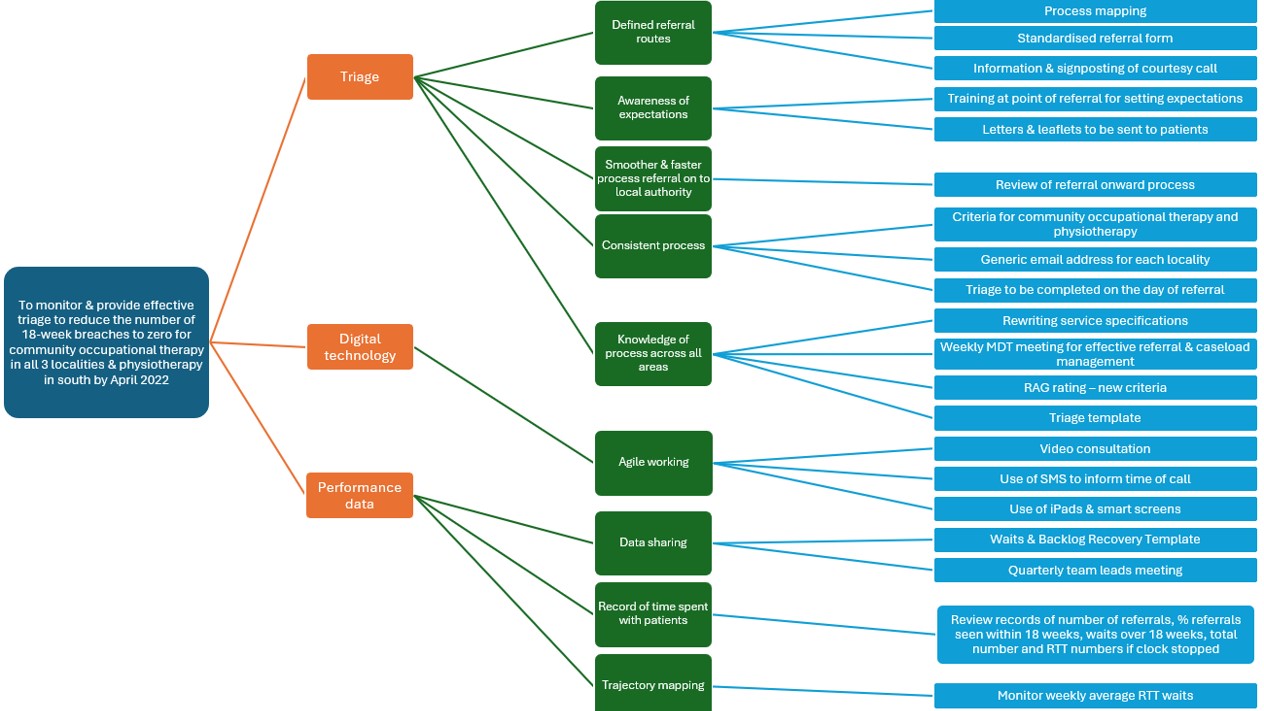
Reduction in 18+ weeks breaches for Community Occupational Therapy and Community Physiotherapy in Bedfordshire Community Health Services
27th August 2024
Lead by: Ellie Gillett, Louise Hughes, and Megan Collins
Coach: Sharon Eplett
Sponsor: Debbie Martin
At the start of the Quality Improvement (QI) project waiting lists were up to 34 weeks wait. The backlog at that time was initially generated because of reduced clinical capacity within the Community Occupational Therapy (OT) and Physiotherapy (PT) services during the Covid-19 pandemic. All normal therapy services were suspended except for urgent cases. Under the Discharge to Assess Model, the workforce – both clinical and non-clinical – was utilised to support all hospital discharges. After which, each locality has returned staff to their pre-pandemic teams.
Aim:
- To monitor and provide effective triage to reduce the number of 18+weeks breaches to zero, for community OT in all 3 localities and community PT in south by December 2022 as shown in Figure 1
Figure 1. Driver diagram illustrating the aim on the left and change ideas on the right
Understanding the problem
The South locality initially had the highest number of breaches and longest waiting times by up to 7 weeks in comparison with the other two localities.
Community Occupational Therapy:
- Actively reassessing the existing caseload, ensuring that the long waiters (those over 17 weeks) still required an assessment and, if not, signposted to an alternative service,
- Assessments to occur over the phone,
- Equipment delivered from the peripheral store or if they can be discharged safely without intervention.
- Saturday 30th October 2021, 6 staff members for 6 hours worked through the breaches. Contact made with the longest waiters to triage, assess and meet their needs as much as possible and if not, appointment booked in. A total of 75 patients were contacted and all clocks were able to be stopped. This saw the waiting list drop from 24 weeks wait to 17, bar 3 patients that were uncontactable.
- This project meant that the South team were closer in line with the Mid and the North localities waiting times.
Community Physiotherapy:
- Criteria and referral process reviewed, as it has been identified that referrals were being put through by Single Point of Access (SPoA) for individuals that are not housebound or require a specific assessment being carried out within their home environment. The waiting list at that time sat at 34 weeks wait.
Change ideas tested
- SPoA referral questions reviewed and trialled as a success, reducing inappropriate referral numbers,
- South team introduced weekly COT/CPT meetings in line with North and Mid to triage, prioritise and allocate cases in order of need.
- Designed a new triage form (reconfiguring the existing holistic assessment).
- Feedback received reported increased pressure on time to complete and due to length of waits would have to re complete nearer to face to face assessment. For those urgent patients the team did see a benefit to completing this form as resulted in shorter administration time required at point of face-to-face assessment.
- Re-designed the old triage form and renamed pre-assessment template to be completed with urgent patients (those needing a visit within 2 weeks)
- Mid team trialled completing this template successfully with long waiters utilising a few bank hours.
- Created a new triage form to ensure continuity of information captured across the localities.
- Updated all therapy service leaflets with the support of People Participation.
- Starting the update of all templates and referral forms on S1.
- Internal ELFT referral process introduced into therapy services.
- Website updated with service information on a ‘interim’ basis, until capacity is increased to support photos/videos and direct links to services.
- Introduced administrative team to book in appointments on behalf of clinicians.
- Appointment ledgers reintroduced to provide admin with up-to-date diaries for appointment booking.
- Administrative staff members received Millbrook training to support urgent equipment ordering on behalf of clinicians.
Conclusion
Figure 2. Waiting list summary at the end of the project
- Waiting lists have dramatically reduced from 34 weeks at its peak and 0 breaches as seen in Figure 2. Figures 3 and 4 show improvement over time.
- Whilst efficiencies have been made to assist with reducing the waiting times, maintaining a healthier waiting list, ultimately more staffing resources will be required to meet the demand; Future increases of referrals and the services to be supported by therapy. The ideal would be to have a waiting list of no longer than 2 weeks and the ability to book in appointments at the time of receiving the referrals.
Figure 3. I Chart illustrating average wait in weeks
Figure 4. P Chart showing the percentage of >18 weeks breaches.
Most Read Stories
-
Why is Quality Control important?
18th July 2018

-
An Illustrated Guide to Quality Improvement
20th May 2019

-
2016 QI Conference Poster Presentations
22nd March 2016
-
Recognising Racism: Using QI to Help Take Action
21st January 2021

-
Using data enabled us to understand our problem
31st March 2023

-
QI Essentials: What does a Chief Quality Officer do?
18th March 2019


Follow QI on social media
To keep up to date on the latest concerning QI at ELFT, follow us on our socials.






